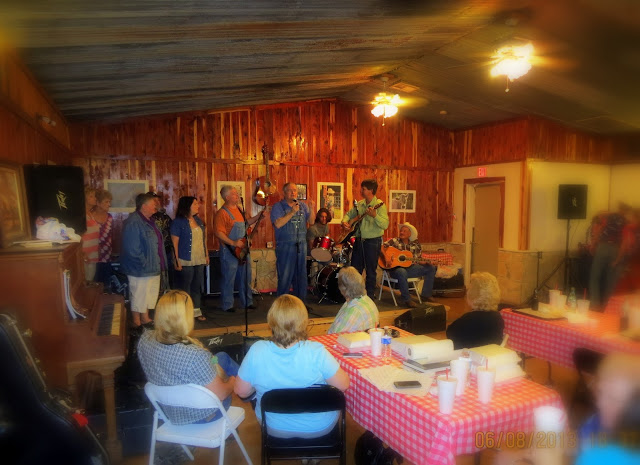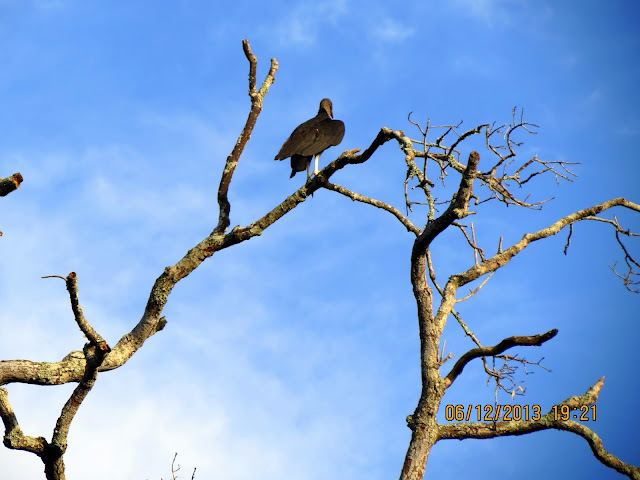Hi Everybody!!
Last Saturday Night I actually went out! I had been invited to my first ever Music Jubilee down at the Barbecue Place on Hwy 6 (Hempstead, Texas). I am a regular enjoying the fine Ribs, but on this special Saturday Night, Dan created a fantastic gathering of local artists to sing Country Gospel Music Songs. Your photostudy tonight is shots from the Jubilee. Your Infostudy is from Wikipedia. Of course, I top it off with pics of Lucy's Baby Buzzard! Enjoy!!
(Sorry-I ate all the ribs and chicken (!) You will have to come to the Jubilee next month to get some for yourself!)
The Artists begin setting up
Everyone else begins eating!
Dan has everything ready to go!
And, the Songs Begin!
This is a Father with his Son and Daughter (All great singers)
WOW-What a great show! Thanks Everybody!
http://en.wikipedia.org/wiki/Jubilee_quartet
Jubilee quartet
From Wikipedia, the free encyclopedia
Jubilee quartets were popular African-American religious musical groups in the first half of the 20th century. The name derives from the Fisk Jubilee Quartet, a group of male singers organized by students at Fisk University in 1871 to sing Negro spirituals, which had typically been sung by mixed choirs before then. Students at other historically black schools, such as Hampton Institute, Tuskegee Institute and Wilberforce University, followed suit.
The early jubilee quartets featured close harmonies, formal arrangements and a "flatfooted" style of singing that emphasized restrained musical expression and technique derived from Western musical traditions. Early quartets reinforced their respectable image by adopting uniforms that a university glee clubmight wear and discouraging improvisation.
In time, however, the popularity of the jubilee style spread from the universities to black churches, where quartets, singing before audiences with a tradition of enthusiastic response, began to absorb much of the energy and freedom of Gospel music coming out of Holiness churches. Groups such as the Golden Gate Quartet--originally named the Golden Gate Jubilee Quartet—infused their performances of spirituals with the rhythmic beat of blues and jazz and gradually began including gospel standards written by Thomas A. Dorsey and others in their repertoire. The Gates and other jubilee quartets gained nationwide popularity through radio broadcasts, records and touring in the 1930s and 1940s.
Other groups, such as the Dixie Hummingbirds and the Original Five Blind Boys of Alabama (formally known as the Happyland Jubilee Singers) that had begun singing in the conventional jubilee style went further, creating the more improvisational and fervent style of quartet singing known as "hard Gospel". That new style largely eclipsed jubilee singing by the 1950s.
External links [edit]
http://en.wikipedia.org/wiki/Barbecue_in_Texas
Barbecue in Texas
From Wikipedia, the free encyclopedia
Barbecue is a traditional style of preparing beef in the cuisine of Texas (United States) and is one of the many different varieties of barbecue found around the world. Texas barbecue traditions can be divided into four general styles: East Texas, Central Texas, South Texas, and West Texas.[1] The Central and East Texas varieties are generally the most well-known.[2] Author Griffin Smith, Jr. in a 1973 Texas Monthly article described the dividing line between the two styles as "a line running from Columbus and Hearne northward between Dallas and Fort Worth".[3]Additionally, in deep South Texas and along the Rio Grande valley a Mexican style of meat preparation known asbarbacoa can be found. The word barbacoa in Spanish means barbecue though in English it is often used specifically to refer to Mexican varieties of preparation.
Generally speaking the different Texas barbecue styles are distinguished as follows. In the East Texas style the beef is slowly cooked to the point that it is "falling off the bone", typically over hickory wood, and marinated in a sweet, tomato-based sauce. In the Central Texas style the meat is rubbed with spices and cooked over indirect heat from pecan or oak wood. In the West Texas style the meat is cooked over direct heat from mesquite wood giving it a somewhat bitter taste. The South Texas style features thick, molasses-like sauces that keep the meat very moist.[1]The barbacoa tradition is somewhat different than all of these. Though beef may be used, goat or sheep meat are common as well (sometimes even the whole animal may be used). In its most traditional form barbacoa is prepared in a hole dug in the ground and covered with maguey leaves
History[edit]
In the U.S. barbecue traditions are believed to have originated when Caribbean slaves were brought to the Carolinas in the 17th century. Indeed the English word barbecue came from the Arawak-Carib word barbracot (via the Spanish word barbacoa). This Caribbean style of slow cooking meat formed the basis of the Southern barbecue tradition that influenced Texas when some of its first American settlers arrived.[5]
European meat smoking traditions were brought by German and Czech settlers in Central Texas during the mid-19th century. The original tradition was that butchers would smoke leftover meat that had not been sold so that it could be stored and saved. As these smoked leftovers became popular among the migrants in the area many of these former meat markets evolved to specialize in these smoked meats.[4]
The subsequent emancipation of the slaves in 1865 gave birth to the East Texas barbecue tradition, which was largely a product of the African American community.[4]
Many well-known barbecue establishments in Texas originated as butcher shops.[6]
In 1964 President Lyndon B. Johnson hosted a state dinner featuring barbecue for the Mexican president-elect in Johnson City. It is generally considered the first barbecue state dinner in the history of the United States.[4]
By 2000 in Texas many old-fashioned barbecue smokers had been replaced by gas-fired ovens due to pollution concerns and due to ease of use.[6]
Regional styles[edit]
Central Texas[edit]
Central Texas barbecue became established in the 19th century in central Texas towns such as Lockhart, Luling, and Taylor. These towns were established by Germans and other European groups. In their early periods, the towns had meat markets that served cooked meat on red butcher paper. The tradition continues in many central Texas towns to this day. Griffin Smith, Jr. of Texas Monthly described the name "Central Texas barbecue" as underestimating the territorial extent of the cuisine type. Many barbecue events are held on Saturday, and many establishments are closed on Sunday. Noon is the time when many barbecues are held.[3]
At a central Texas barbecue restaurant, the customer takes a tray. One staff member serves the customer the meat and often also carves it, while another server provides side dishes. Slices of packaged white bread are often included with the barbecue. Barbecue, sold by the pound, often includes beef ribs, brisket, chicken, pork ribs, and sausage. Some establishments serve clod (beef shoulder).[7] The emphasis of the barbecue style is on the meat. If sauce is available, it usually is a side dip.[3] Calvin Trillin, writing in The New Yorker, said that people who discuss central Texas barbecue do not talk about the piquancy of the sauces or the tastes of side dishes such as beans; the discussions tend to center around the quality of the meat.[8] In many restaurants barbecue sandwiches are not served. The customer may take a piece of bread and roll it around the meat or the customer may not use bread and instead use his or her fingers to eat the meat. Some orders may include saltine crackers, onions, jalapeños, and pickles. [3] Pickled vegetables like carrots, onions, and jalapeños are generally available.
Smith explained that a theory of how Central Texas barbecue formed is that the noon meat markets were dominated by the upper classes, who could choose among the highest quality cuts of meat. Because of this they did not have an interest in the sauces. Smith described many sauces in Central Texas barbecue as "bland" compared to the flavor of the meats themselves.[3] The sauce is typically thinner and less sweet that other barbecue sauce, such as the sauce made in the South Texas or Kansas City style which rely heavily on molasses, sugar, and corn syrup to provide thickness and sweetness.
Central Texas was settled by German and Czech settlers in the mid 19th century, and they brought with them European-style meat markets, which would smoke leftover cuts of pork and beef, often with high heat, using primarily native oak and pecan. The European settlers did not think of this meat as barbecue, but the Anglo farm workers who bought it started calling it such, and the name stuck. This style is found in the Barbecue Belt southeast of Austin, withLockhart as its capital.[9][page needed]
Jayne Clark of the USA Today said in 2010 that the "Texas Barbecue Trail" is a "semi-loop" including Elgin, Lockhart, Luling, and Taylor. All of the communities are within one hours of a drive from Austin from the northeast to the southeast.[10]
East Texas[edit]
East Texas barbecue is usually chopped and not sliced. It may be made of either beef or pork, and it is usually served on a bun. Griffin Smith, Jr. of Texas Monthly described East Texas barbecue as an "extension" of barbecue served in the Southern United States and said that beef and pork appear equally in the cuisine. He also said that the "finest manifestations" of the East Texas style are found in restaurants operated by African-Americans. Unlike other versions of Southern barbecue, Texas barbecue does not include cole slaw.[2] Smith said that East Texas barbecue "is still basically a sandwich product heavy on hot sauce."[11] Smith discussed a theory that circulated regarding how and why East Texas barbecue, which is heavily sauced and chopped, started. Smith explained that the theory stated that the barbecue was originally an African-American method for handling poor quality cuts of meat, as African-Americans were unable to receive higher quality cuts of meat. The hot sauce was emphasized in the cuisine, as it covered the flavor of some cuts of meat.[3]
The style often uses cuts such as pork shoulder and pork ribs, indirectly slow smoked over primarily hickory wood. The sauce is tomato-based, sweet, and thick. This is also the most common urban barbecue in Texas, spread by African-Americans when they settled in big cities like Houston andDallas.[9][page needed]
Other styles[edit]
West Texas barbecue, sometimes also called "cowboy style," uses a more direct heat method than other styles. The main wood used is mesquite, and in addition to beef, goat and mutton are also cooked.[9][page needed]
The border area between the South Texas Plains and Northern Mexico, as well as its barbecue style, are mostly influenced by Mexican tastes. The area was the birthplace of the Texas ranching tradition, and the Mexican farmhands were often partially paid for their work in less desirable cuts of meat, such as the diaphragm, from which fajitas are made, and the cow's head. It is the cow's head which defines South Texas barbecue, called barbacoa. The head would be wrapped in wet maguey leaves, buried in a pit with hot coals for several hours, and then the meat for barbacoa tacos would be pulled off. The tongue would also be used to make lengua tacos. Today, barbacoa is mostly cooked in an oven in a bain-marie[9]
GOOGLE PLUS PAGE LINK FOR HILL COUNTRY BARBECUE:
https://plus.google.com/112413553477732634877/about?gl=us&hl=en
If You want to Know, just ask Jo!
*permission to photograph at the Jubilee Event by Dan and Jo Hill-b
This is Lucy's Baby Buzz!
Black Vulture
...this is brendasue signing off from Rainbow Creek. See You next time! Take Time for YOU!
O+O



































No comments:
Post a Comment
Hi Everybody! Please say hello and follow so I know you are here! Due to the inconsideration of people trying to put commercials on my blog comment area, I have restricted use of anonymous posts. Sorry that some hurt all.
My public email is katescabin@gmail.com No spammers or trolls